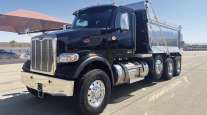Freightliner Faces Shortages Of Many Parts, Exec Says
This story appears in the Aug. 22 print edition of Transport Topics.
NAPA, Calif. — North America’s largest heavy-duty truck maker is struggling to find the parts necessary to build all the trucks it has agreed to supply to fleets during 2011, and has had to turn down “thousands” of orders, according to a senior company official.
Mark Lampert, senior vice president of sales and marketing for Daimler Trucks North America, said the supply crunch has spread from major components — such as engines, pollution control devices, tires and axles — to smaller components, such as floor mats.
“We’re hoping and praying” we’ll have enough material to produce all the trucks we’ve promised to sell, Lampert told a group of journalists at a company-sponsored event here.
“We’ve lost thousands of orders to competitors,” Lampert said during an interview Aug. 11, because virtually all of Freightliner’s 2011 production slots have been pledged since late May.
He said he was hopeful that some of the lost business may simply be pushed off into 2012 when customers are unable to find alternatives.
Freightliner is not alone in the supply crunch, as all the major truck manufacturers have reported some serious parts shortages.
Lampert said DTNA has raised its sales forecast for this year several times, and it now projects 158,000 Class 8 sales in the United States. He said that combined, the truck makers probably could have sold about 175,000 vehicles this year, had it not been for the widespread shortages.
Through July, U.S. Class 8 truck sales are 43.9% ahead of 2010’s pace. Sales in the United States make up the bulk of North American activity.
When asked if all North American truck makers would be able to sell every vehicle they can produce this year, Lampert said, “absolutely.”
He said the company has already raised its 2012 forecast to 208,500, and has advised its suppliers to be ready. It was the truck makers’ collective failure to anticipate the demand surge that led their suppliers to not produce sufficient parts, he added.
Despite the lagging economy, heavy-duty truck sales have surpassed industry expectations by a wide margin as carriers push to modernize their fleets in surprisingly high volumes. Most fleets said they aren’t expanding capacity, because of an uncertain outlook for freight volumes.
Lampert said the truck makers have been unable to find alternative supplies of parts anywhere in the world because business is also booming in two major overseas markets — China and Brazil.
While total U.S. sales in Classes 6-8 are now expected to be around 250,000, Lampert said some 950,000 such trucks will be sold in China this year.
Lampert spoke during a two-day press event Freightliner hosted to publicize its new marketing campaign under the banner “Undisputed Market Leadership.”
A group of company officials touted the quality of Freightliner products and discussed the strides it has made in improving fuel efficiency and the reliability of its vehicles.
The event came just days after President Obama unveiled the first fuel-efficiency standards for heavy-duty trucks.
David Hames, DTNA’s general manager of marketing and strategy, said the company was going to make a package of aerodynamics improvements available to customers, which would help Freightliner Trucks reach the new mandated average of 7.9 mpg in 2014, up from the 6.9 mpg average this year.
Hames said there were no “radically new technologies” necessary for the company’s trucks to meet the first-ever fuel efficiency standard.
He said fleet concerns have changed a great deal in recent years. In 2010, Hames said, the number one concern was price, while today it’s fuel economy, followed by reliability and weight reduction.
Tim Tindall, director of component sales for DTNA’s Detroit Diesel engine subsidiary, said, “Everything we do [today] centers around fuel consumption.”
Meanwhile, Brian Cota, Freightliner Trucks’ vice president of sales, unveiled details of Freightliner’s new “virtual technician” program, which will automatically diagnose engine problems on new vehicles as they occur and advise owners where to go for repairs, in an effort to reduce vehicle downtime.
He described the feature, which will be standard on all new Freightliners, as “a virtual cable” that runs from the truck to a DTNA technician.
The aging of the domestic truck fleet, caused by carriers delaying purchases of new vehicles in recent years during the recession, has had a bright spot for at least one DTNA division.
John O’Leary, DTNA’s senior vice president of aftermarket, said Freightliner is now selling some $9 million a day in parts, compared with $6.5 million in March 2010.




